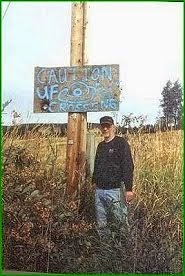
Houston Today Newspaper
Wednesday, October 1, 2003
No 40
As told by Ed Westgarde
Guiding, prospecting and trapping, Ed Westgarde naturally takes a avid interest in wildlife, and consequently found that they, like humans, are susceptible to a variety of accidents that can lead to their deaths.
Westgarde says he was recently shown what he calls "one of natures most vicious accident and death-causing animal traps."

How many animals have died here, he's not sure, but says that the bones and skulls of animals of all ages surround what he called a bone yard.
For anyone passing by, the bone yard appears to be just another harmless puddle in a grassy area, measuring about 10 feet across, with one large exception...the mass of hair that floats across the top.
According to Westgarde, there is no running water or moving water here, and the sides of the pond are straight up and down with no bottom in sight. He can only assume that an animal steps in to take a drink, but then plunges to the bottom. He says there are marks from pawing hooves, indicating that some animals may have been able to paw their way out, but not many, due to the large number of bones lying around.

As strange as this hole is, Westgarde says it is not the only one, that nearby there are a few smaller holes, the sides of which are also straight up and down, and also with no apparent bottom.
According to Westgarde, these wildlife traps were discovered by Lorne Spence, who is well known across British Columbia, the prairie provinces and the Northern United Sates for his mineral exploration and drilling, while staking mineral claims in the area.
Westgarde says that in the 1930s, a man by the name of Emil Widen claimed to have seen meteorites fall in the area, but that he was unable to find where they landed.
"Do you think they made these holes?" Westgarde asks.
He wonders if the area should be fenced off...for safety sake.
Wednesday, October 1, 2003
No 40
As told by Ed Westgarde
Guiding, prospecting and trapping, Ed Westgarde naturally takes a avid interest in wildlife, and consequently found that they, like humans, are susceptible to a variety of accidents that can lead to their deaths.
Westgarde says he was recently shown what he calls "one of natures most vicious accident and death-causing animal traps."

How many animals have died here, he's not sure, but says that the bones and skulls of animals of all ages surround what he called a bone yard.
For anyone passing by, the bone yard appears to be just another harmless puddle in a grassy area, measuring about 10 feet across, with one large exception...the mass of hair that floats across the top.
According to Westgarde, there is no running water or moving water here, and the sides of the pond are straight up and down with no bottom in sight. He can only assume that an animal steps in to take a drink, but then plunges to the bottom. He says there are marks from pawing hooves, indicating that some animals may have been able to paw their way out, but not many, due to the large number of bones lying around.

As strange as this hole is, Westgarde says it is not the only one, that nearby there are a few smaller holes, the sides of which are also straight up and down, and also with no apparent bottom.
According to Westgarde, these wildlife traps were discovered by Lorne Spence, who is well known across British Columbia, the prairie provinces and the Northern United Sates for his mineral exploration and drilling, while staking mineral claims in the area.
Westgarde says that in the 1930s, a man by the name of Emil Widen claimed to have seen meteorites fall in the area, but that he was unable to find where they landed.
"Do you think they made these holes?" Westgarde asks.
He wonders if the area should be fenced off...for safety sake.







































































































































No comments:
Post a Comment